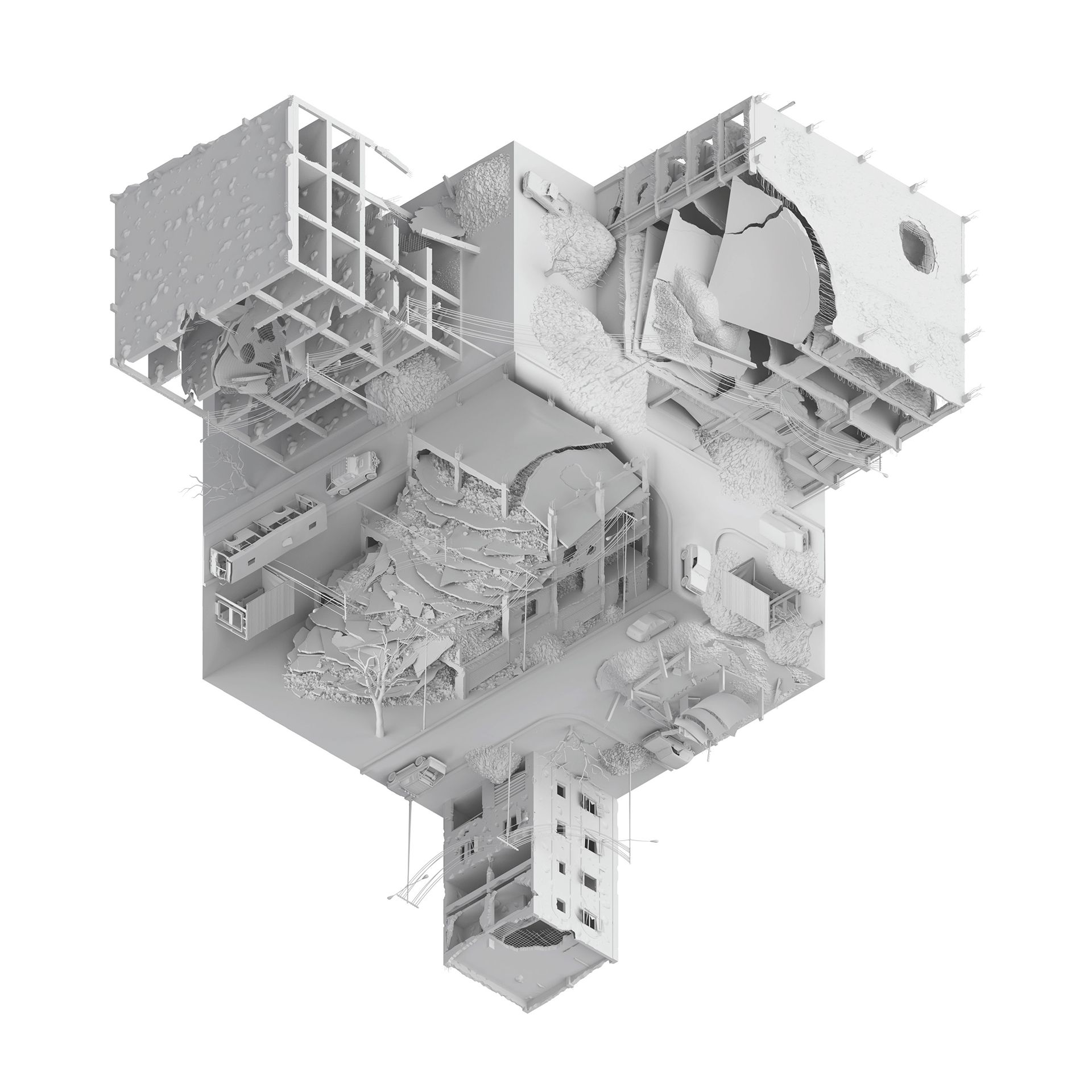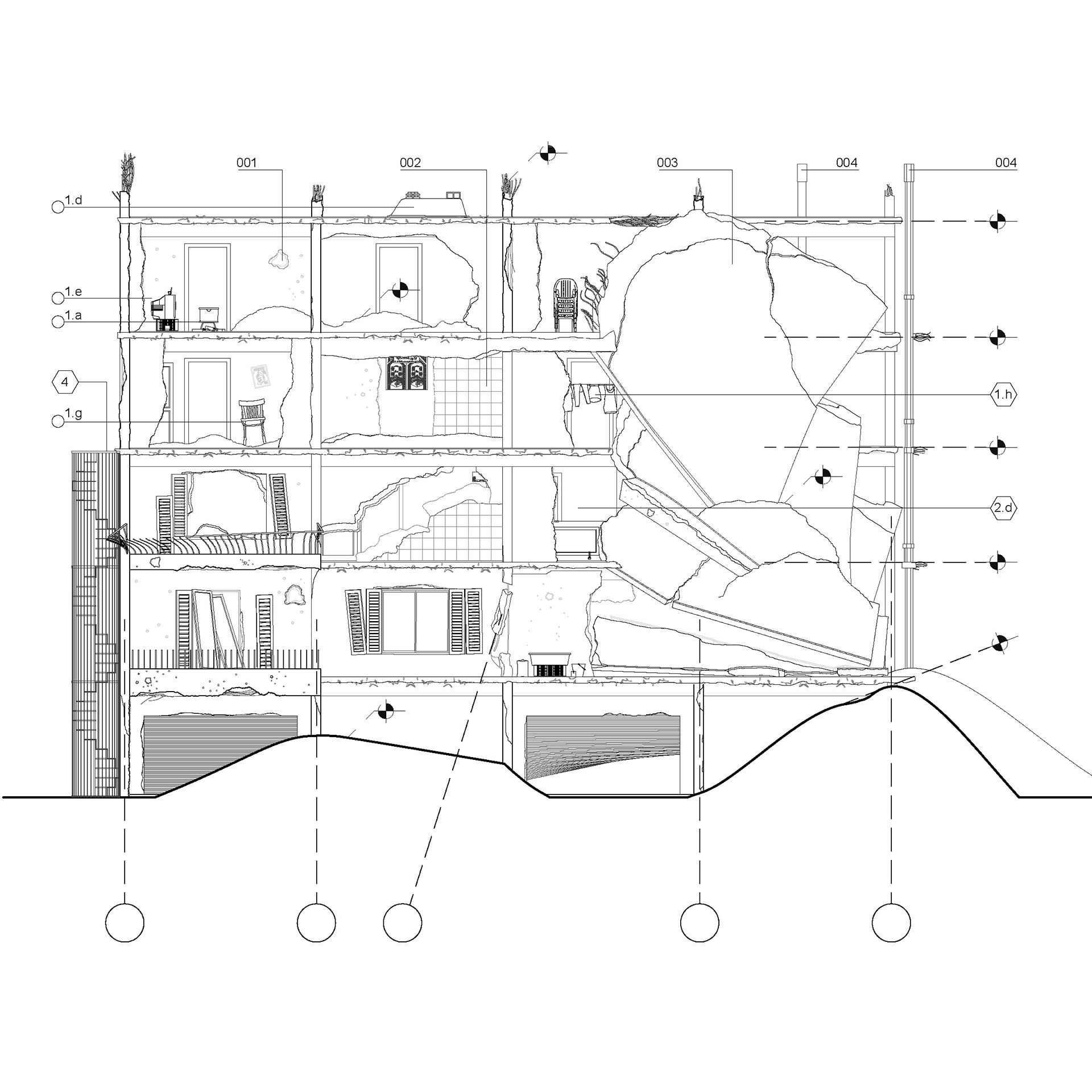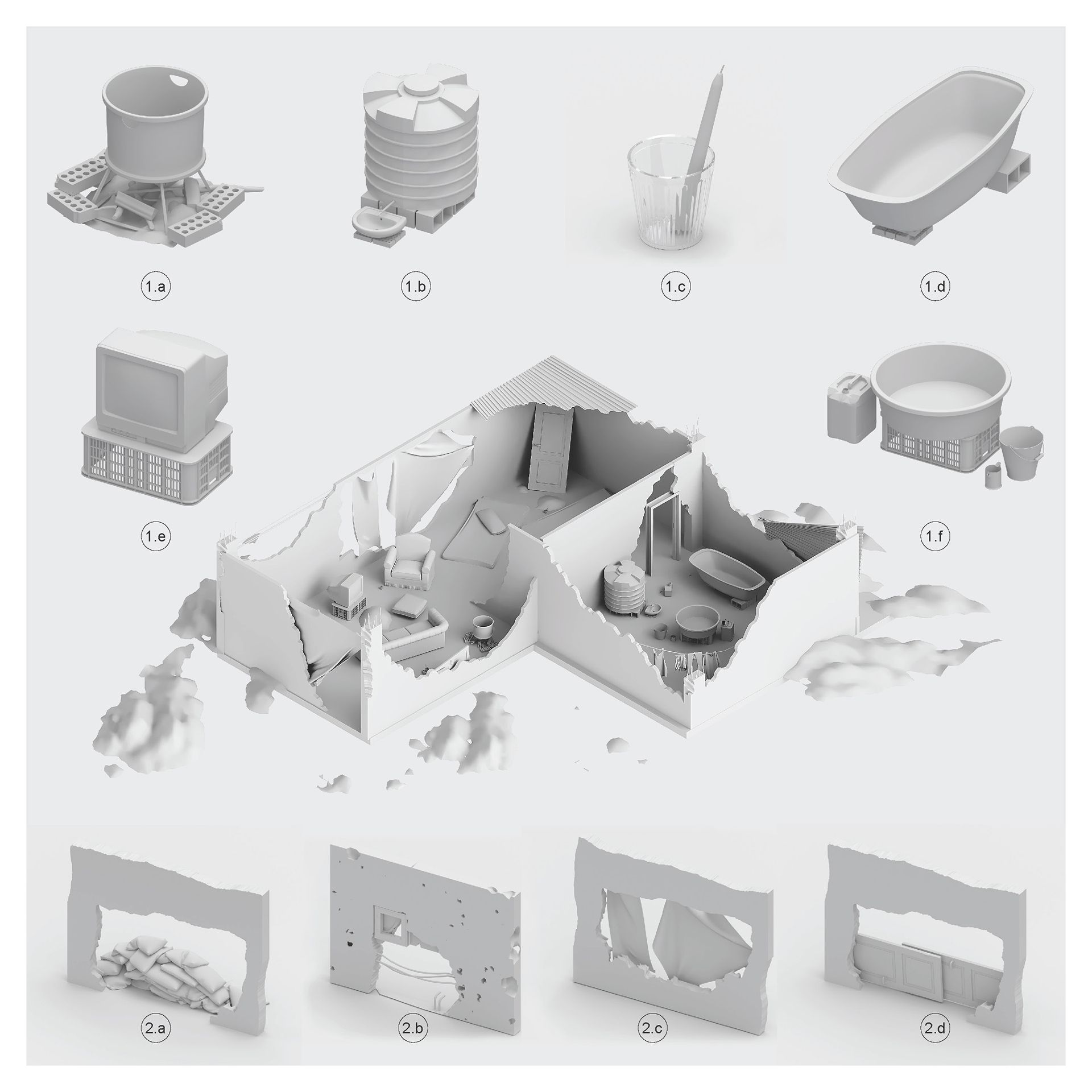“That was a home,
That is a home,
That will remain a home,
to someone to a community to a nation whose future has been redrawn and redirected nowhere near the international destination.
A home that refuses to be silenced, that tells the story of the living and the dead; that claims ownership and right. Even though time seems to stand still eventually the human survival instincts take the lead; adapting and adjusting, making walls out of fabric and using wood and fire just like old times to provide food and warmth.
Architecture that cries out death yet elements describing a life of survival, resilience and adaptation.”

KOOZ What prompted the project?
SR, AY, MI The brief of the competition asked us to speculate on the future of Home. At first, we started discussing the future of architecture and how it will be affected by technology. But during that time the Beirut explosion had occurred which was very sudden and unexpected and images of destruction of the city were everywhere. Being from the Middle East and at a great proximity to not just Beirut, but other ruined areas such as Gaza, Yemen, Syria, …etc. We felt a disconnection between the future we were discussing and the reality around us.
That’s when we decided to shift our focus to the uncertainty of the future of these cities.
Being from the Middle East [...] we felt a disconnection between the future we were discussing and the reality around us.
KOOZ What questions does the project raise and which does it address?
SR, AY, MI The project focuses on violence (the violence produced by natural, political or economic reasons), and on the topic of violence it raises multiple questions: how architecture is transformed by violence and how that Violence imposes new architectural language through the deconstruction of the conventions of architecture. Opening up walls, digging holes in the ceiling, letting light in dark areas and obscuring the light in light areas, making accessible what is inaccessible and blocking the access of what is accessible. Every assumption of architecture such as the distinction between the interior and the exterior, how to provide protection against the elements is violently subverted. On the other hand, how people adapt to this situation creating a different form of architecture, one of survival and resistance, a desperate attempt to maintain a form of normalcy and a sense of control and agency in an uncertain condition.
How fragile the structure of our day to day life is, how unstable the notion of normal life is, by examining the situations where this sense of normalcy is destroyed in a horrific suddenness. And in the context of the competition, and the international discussion about the future, how some people are excluded from this discussion because their life abruptly stopped and their future is dispossessed.

KOOZ How does the project approach and define the notion of home?
SR, AY, MI There is a form of sacred value of shelter when talking about home, it is usually associated with a sense of security and privacy, it is regarded as a sanctuary from the outside world, our project examines how Violence redefines this notion when it violates the sanctity of the home, when the exterior world intrudes the private domestic life.
Here Home takes a different form: it is a fragile temporary shelter that barely holds up by instincts of survival and adaptation. It stands vulnerable inhabiting its former shell in a state of perpetual wait of its inevitable destruction. It is also expressed Through the objects used in the domestic activities of everyday life. We examined how these simple activities take a different form in this new context.
There is a form of sacred value of shelter when talking about home [...] our project examines how Violence redefines this notion [...] when the exterior world intrudes the private domestic life.
KOOZ How does the project challenge the role and potential of architecture beyond the built form?
SR, AY, MI We perceive buildings as containers of human activities. And these activities whether social, economic or political have an interchangeable relationship with its setting, therefore every discussion about architecture is an indirect discussion about the human condition.
Architecture usually provides ease, comfort and optimistic dreams about the future. But, we are interested in architecture that disturbs, discusses the uncomfortable and confronts the horrific; expressing our reality from a vantage point that gives us insight . Architecture as such focuses less on providing easy answers and more on raising questions. The Architecture transformed by violence opens up discussions about life and death, the future and the endless present, about desperation, resistance and hope.
The language of architectural drawings (Diagrams, Elevation, section, isometric) was our way of presenting the project as it tends to be as objective as possible in expressing the traumatic reality. As if not to engage emotionally the drawings are empty without people; only describing spaces and objects.
KOOZ What are the ultimate responsibilities of the architect today and for the future?
SR, AY, MI Architecture is a profession with a big responsibility and limited power. Architects are presented with big questions to provide answers to; dealing with issues both globally and locally they can hardly grasp. Nevertheless, buildings have to be built and cities have to be constructed. In dealing with destroyed cities and the process of rebuilding, there’s a bigger discussion to be had that goes beyond the role of the architect, that needs the whole society to engage in. But the architect by definition and duties of his profession is at the middle of this discussion and must lead the process.
Questions on how to deal with trauma, how to handle the scars of violence left on the walls of the city. There are no easy answers. But we think a great way to start is to understand the trauma and confront it. And as horrific and painful experience the destruction of a city is, it offers an opportunity to Change and reevaluate our ways of living and understand the reasons of failure hopefully to improve.
As lebbeus woods puts it :
“Loss is necessary in order for us to change, not only in our habits, but also in our understandings and beliefs. As long as we cling comfortably to what we are and know, we cannot learn, or create. If design is to be a creative act, it must take on the most difficult situations in our lives. It must offer more than comfort and reassurance. It must confront the unspeakable—the ineffable—and become a means by which we can transcend it”.






